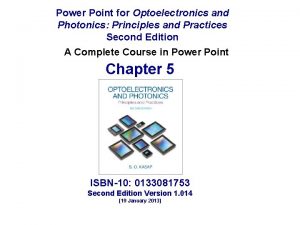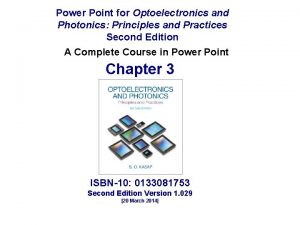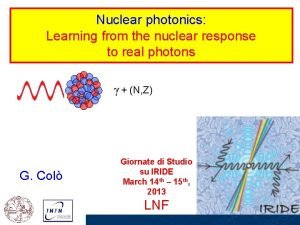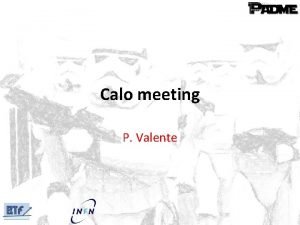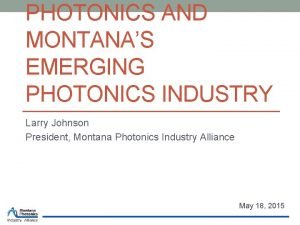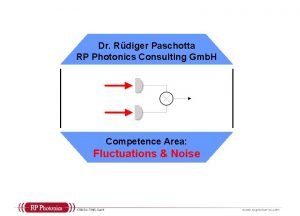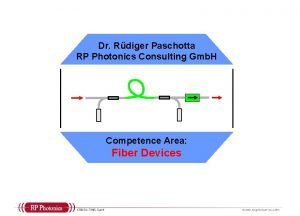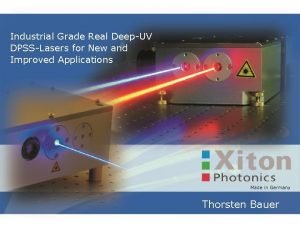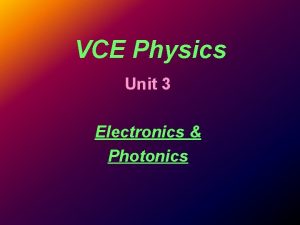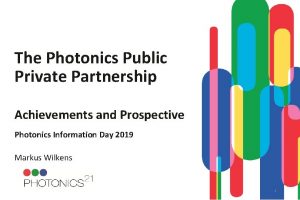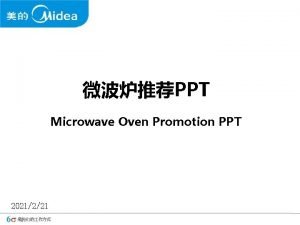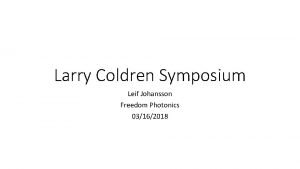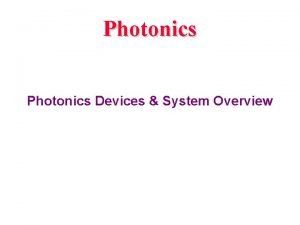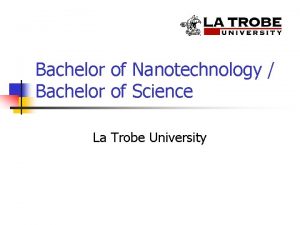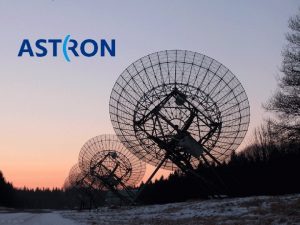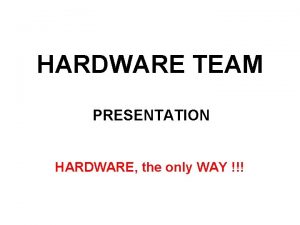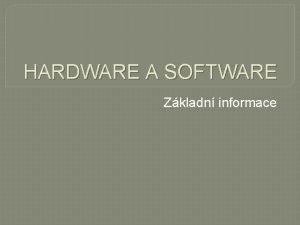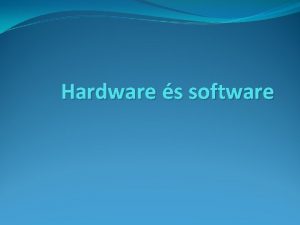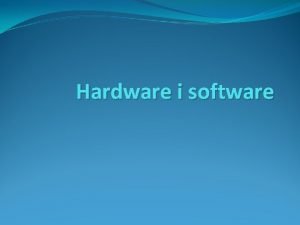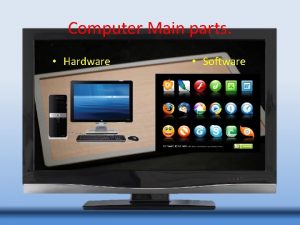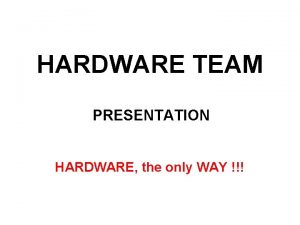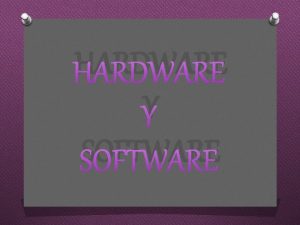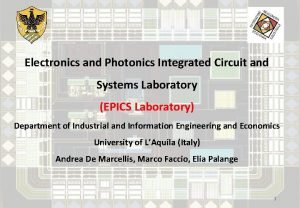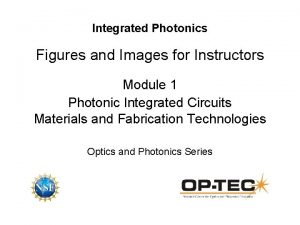Integrated photonics to revolutionize the Data Center hardware























- Slides: 23

Integrated photonics to revolutionize the Data Center hardware Marco Romagnoli CNIT & Te. CIP - Scuola Superiore Sant’Anna

Zettabyte era • • • Disaggregation at system level Integration at chip level Optical interconnection at shorter reach Electronics-photonics convergence Cost, energy and bandwidth density Architecture, components, programming Make it happen or end the information age

Example of large volume applications • Active Optical Cable • Wireless communications • 100 GE Optical Interfaces (CFP, CXP, CPAK, QFSP, . . ) • Inter Chip and Board Level Interconnection

Optical Interfaces for Different Network Platforms Telecom (CFP) Datacom (CXP, CPAK) Data center access Data center aggregation Edge routing The Optical challenges: Bandwidth Density Consumption Cost Core routing

The CFP (C Form-Factor Pluggable) optical module to enable Terabit blades or line-cards The next-generation CFP modules - the CFP 2 and CFP 4 (10/40 km) multiplies the number of 100 Gb/s optical module interfaces on a blade. Using the CFP 4, up to 16, 100 Gbps modules will fit on a blade, a total line rate of 1. 6 Tb/s. With a goal of a 60 W total module power budget per blade, that equates to 27 Gb/s/W. In comparison, the power-efficient SFP+ achieves 10 Gbps/W.

Inter Chip and Board Level Interconnection Case study: «Optical PCIe 3. 0» working group within the Communication Technology Roadmap (CTR 4) of the Microphotonics Center Consortium (MPh. C) at MIT

Chip to Memory Interconnection through Si interposer

Technology • Photonic Electronic Integration • Silicon Optical Interposer • Si Photonics readiness • Laser Integration

Si Photonics - Advantage of full integration Cost: photonic-electronic chip (development, mask set, wafers, manufacturing). Save in packaging, wire bonding and traces/pin-out. Technology: low capacitance 3 D integration. Node scalability, low consumption and improved yield. Performances: trade off between consumption, size, IL and link/system specs Maturity of individual components: to be improved but not conceptually limited. 50 line Photonic chip 9

Photonic Electronic Layer - 3 D Integration 3 D integration of SOI technology for the photonic layers with Si CMOS circuit layers. Integration in a 65 nm node/12” fab based on wf/wf or wf/die bonding and low capacitance TSV technology. Bond Pads Si Logic Layer Si TSV Thermal Compression Bonding Mod PD BOX SOI Photonics Layer Si waveguide Substrate 10

Electrical Interconnect Limitations • • Bandwidth Limitations – Wires are not scalable i. e. bandwidth is limited by area Power Limitations - Total interconnect power is high ~50% of Total Chip Power Expected to rise to >80% (limit 200 W). • • • Signal Integrity and Latency (RC delay) will increase considerably with scaling, sheet Resistance and Capacitance increase as RC = Rsheet. Csheet/� 2 Xtalk between metal wires requires a minimum pitch that limitates interconnection density Repeaters in electrical lines increase delay Al/Oxide + Gates Cwire= 2 p. F/cm Rwire= 20 /cm Al/Oxide Sam Naftziger, AMD fellow 2011 VLSI Symposium Keynote Cu + Gate Cu Gate

Optical Interconnect and Switching • • Optical links are distance and power independent BW density can increase by wavelength multiplexing Latency is given by propagation distance (5 ps/mm) Optical switching Reconfigurable Optical Add Drop Multiplexer CNIT/Ericsson OFC 2014

Si Interposer and Si Optical Interposer Si Interposer Metal Pad / via 100 nm P + Si Optical Interposer Coupler Optical Fiber I/O Silica Waveguides 480 nm 220 nm P N Oxide N + N P MZI Modulato Si r Substrate Heat Sink Micro Bumps HMC P + BOX Interposer Package Redistribution layer Flip Chip Bumps BGA Balls Interpose / Photonics Layer TSV 1. 5 um Silicon Waveguides, resonators, detectors HMC ASIC PG + e N Silicon + Waveguide Ge Photodetect or Redistribution Layer

Si Photonics Modulators Parameter/device type MZI Microring MZI MOSCAP FK Ge EAM Hybrid In. P/Si MZI Bandwidth (nm) >20 0. 1 >100 20 100 Temp Sensitivity (GHz/K) NA 3 ÷ 10 NA NA ? Energy Cost (f. J/bit) 5 ÷ 30 x 103 7 ÷ 50 * 500** 50 ÷ 100 8000 (state switching) Footprint (µm 2) 200 ÷ 10000 20 ÷ 100 500 x 5 25 250 ÷ 500 Speed (GHz) 30 25 10*** 30 25 Insertion Loss (d. B) Extintion Ratio (d. B) 7 7 15 3 ÷ 4 4 1 @ 30 Gb/s 8 @ 16 Gb/s >10 4 ÷ 7. 5 10 @ 25 Gb/s, 18 static 6. 5 1 ÷ 2 1 4 1. 2 Phase adjustment 0. 2 nm/m. W (thermal) Phase adjustment Voltage Static Tuning * add 100 f. J/bit for thermal trimming ** 1 p. J/bit including driver *** progressing towards 40 Gb/s

Si Photonics: Accumulation Modulator

Si Photonics: Detector Integration Responsivity (A/W) @ 3 d. B bandwidth (GHz) 1550 nm Dark Current Device Density (μA) @ -1 V Design Max 1. 0@-3 V 0 bias - Max 4. 5@-3 V 0 bias - (m. A/cm 2) 0. 7* 2× 10 -4 1. 08 7. 2 6. 6 1. 3 x 103 * 1 1 0 25@-6 V - 6. 5 x 105 * 130 0. 89 31@-2 V 15. 7 51@2 V 0. 85 26 - 0. 65 - 18 Reference butt, p-i-n top, p-i-n butt, msm Liu 2006 Beals 2008 Ahn 2007 0. 17@-2 V bottom, p-i-n Yin 2007 - 3 bottom, p-i-n Masini 2008 - 125 0. 06 bottom p-i-n Wang 2008 1. 3 butt p-i-n butt, p-i-n bottom msm bottom, p-i-n bottom, JFET Feng 2009 1. 1 - 37@-3 V 17. 5 1. 6× 104 1@-4 V 0. 2 42@-4 V 12 60 0. 018 0. 42 0 40@-2. 5 V - - 90 0. 95 - 36 - 29 0. 0046 0. 64 - 8 - - 0. 5 Vivien 2007 Vivien 2009 Assefa 2010 Liao 2011 Wang 2011 J. Michel et al. , Nature Photonics, 4, 527 (2010) 16

ADN 3000 -06/11 Integrated Optical Receiver (Analog Devices) • Wavelength agnostic: works across all key optical wavelengths including 850 nm, 1310 nm and 1550 nm • No bonding wires • Single, fully-tested die solution reduces cost: No separate tests required for the TIA and PD • 65 -m. W power consumption: 50 percent powewr reduction compared to standard designs Differential Optical Pricing Each Data Rate Detector Size Output Modulation Per 1000 (Gbps) (um) Swing (m. V p Amplitude -p) (d. Bm) Power Dissipation (m. W) Product Sample Availability ADN 3000 -06 -50 Now $3. 95 6 50 240 -19 65 ADN 3000 -11 -35 Now $5. 95 11 35 240 -17 65 APPLICATIONS Optical receivers up to 10 Gbps 6 G CPRI, OBSAI, and 8 G short range and LTE receivers Receiver optical subassemblies (ROSA)

Si Photonics Full integration: Integrated Laser Source VCSEL: conventional solution for <100 m reach. Good for power consumption, temperature stability, packaging and cost. MM and SM version. High T operation. Hybrid mounting III-V Laser: conventional solution. It can be butt coupled or coupled through grating coupler. Coupling loss 1 ÷ 3 d. B, Packaging, assembly. Cost and large consumption. High T operation. Bonded III-V Laser: remarkable solution with a certain maturity. CMOS manufacturing to be demonstrated. High T operation. Quantum Dot Laser: It can be butt coupled or coupled through grating coupler. Coupling loss 1 ÷ 3 d. B, TEC, Packaging, assembly. Very high T operation. Ge Laser: early stage. Monolithic integration. Potential good performance (power and threshold). Large gain BW and wide tunability. Best at high T (80 ÷ 100°C). 18

Aurrion • Hybrid Silicon Platform bonds III/V wafer or die to silicon. 150 -mm wafer bonding and processing possible; • III/V processed in low-temperature backend process; • Mode couples to III/V optical gain, detection or modulation from III-V Material. Fujitsu • Hybrid III/V SOA mounted on Si Platforrm; • Mode butt couples to III/V optical gain Fujitsu

Quantum Dot Laser - In. As multi-stacked quantum dot active layers sandwitched by Ga. As/Al. Ga. As cladding layers on a 3 -inch Ga. As substrate - Leading-edge highly-uniform, and high-density quantum dots for high optical gain - Light emission wavelength of 1. 21 to 1. 29 μm at room temperature


Conclusion Assuming • Maturity of Si Photonics, good performance, component availability • Initial stage of photonics electronics integration Needs • Low consumption, uncooled operation laser integration evolution • Photonic Electronic convergence through Si optical interposer (3 D integration, TSV’s interconnections) Result • Huge energy saving • Latency control • Increased BW density • Miniaturization • Lower costs Zettabyte Era

thank you! email: marco. romagnoli@cnit. it
 Internal and external components of computer
Internal and external components of computer Optoelectronics and photonics chapter 3 solution
Optoelectronics and photonics chapter 3 solution E-k diagram
E-k diagram Nuclear photonics
Nuclear photonics Hzc photonics
Hzc photonics Montana photonics industry alliance
Montana photonics industry alliance Rp photonics
Rp photonics Paschotta
Paschotta Xiton photonics
Xiton photonics Electronics, photonics and device physics
Electronics, photonics and device physics Photonics
Photonics Microwave devices ppt
Microwave devices ppt Freedom photonics
Freedom photonics Photonic devices
Photonic devices Bachelor of science la trobe
Bachelor of science la trobe Integrated control center
Integrated control center Tramlink extension
Tramlink extension Hát kết hợp bộ gõ cơ thể
Hát kết hợp bộ gõ cơ thể Bổ thể
Bổ thể Tỉ lệ cơ thể trẻ em
Tỉ lệ cơ thể trẻ em Voi kéo gỗ như thế nào
Voi kéo gỗ như thế nào Chụp tư thế worms-breton
Chụp tư thế worms-breton Chúa sống lại
Chúa sống lại

